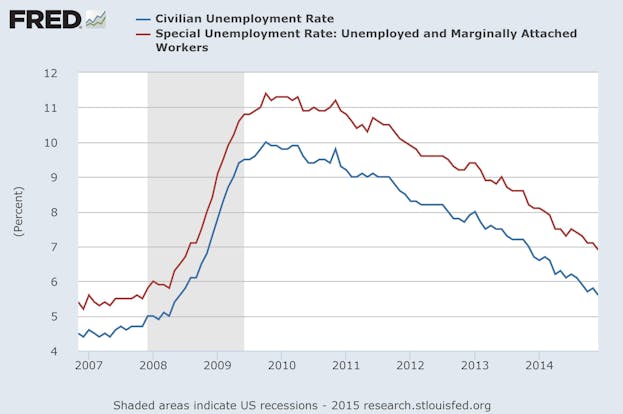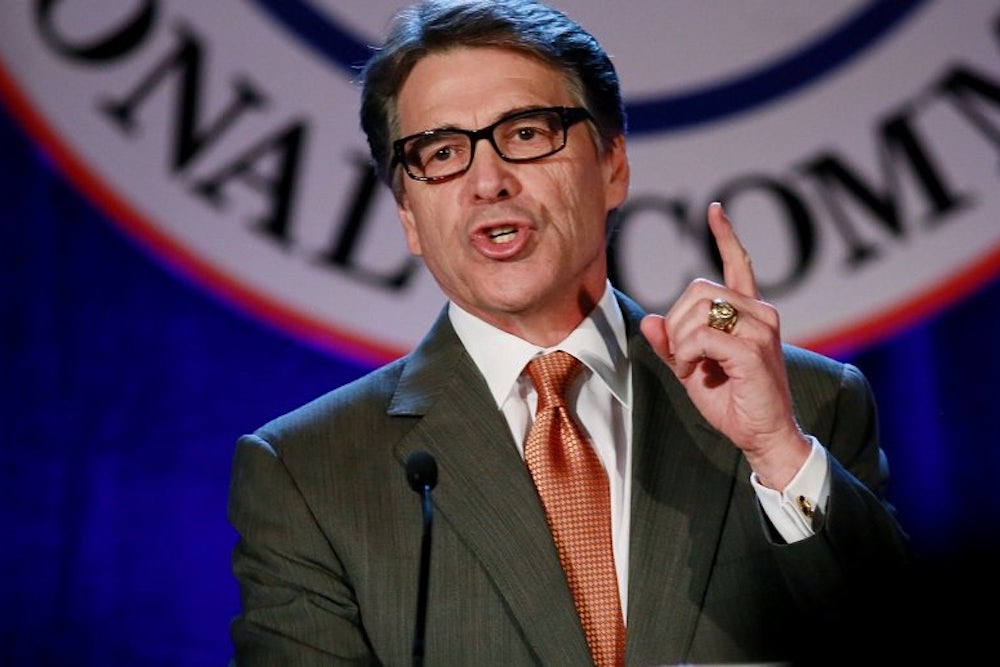At the annual Conservative Political Action Committee (CPAC) in National Harbor, Maryland, on Friday, former Texas Governor Rick Perry drew cheers when he declared, “The unemployment rate is a sham.” He’s not the only one who feels that way. Just a few weeks ago, Jim Clifton, the CEO of Gallup, called the unemployment rate a “Big Lie.” Perry and Clifton are wrong: There’s nothing fake about the unemployment rate. But Perry’s comments are indicative of the Republican Party’s inability to criticize the economy under President Barack Obama.
The Labor Department calculates the traditional unemployment rate—the one you see cited in newspapers and on cable TV—by dividing the number of unemployed people looking for work by the number of employed people and the number of unemployed people looking for work. Currently, it is 5.7 percent. The idea that the government is rigging the number, like some on the right thought before the 2012 presidential election, is preposterous. That simply isn’t happening.
But Perry and Clifton aren’t arguing that the traditional unemployment rate, technically known as the U-3 measure, is fake. At least, I’ll give Perry the benefit of the doubt that he’s not arguing that. Instead, they believe that the unemployment rate does not offer a realistic representation of the labor market—and they’re not wrong. The U-3 measure doesn’t take into account people who have dropped out of the labor market altogether, too discouraged to look for work. That happened to a lot of people after the Great Recession. Construction workers, without any job possibilities, simply stayed home and stopped searching for jobs. In fact, millions of working-age Americans dropped out of the labor market.
But the Labor Department releases a number of measures of the labor market—five other unemployment rate statistics, in fact. The U-5 measure, for instance, includes not just unemployed workers but also discouraged workers and any other workers who are “marginally attached to the labor force.” Currently, it is at 7.0 percent, and it has been falling at basically the same rate as the U-3 measure over the past four years. (The blue line is the U-3 measure, the red line is the U-5 measure.)

Each unemployment statistic tells something different, and none of them is a “sham.” For instance, it’s important to know that while the labor force is tightening up, many workers are still on the sidelines. That has important implications for monetary policy decisions at the Federal Reserve.
But Rick Perry didn’t bring up the unemployment rate to discuss monetary policy. He wanted to damage Obama’s economic record. That goal is becoming tougher to achieve as the recovery strengthens. Conservatives can no longer point to the traditional unemployment rate as a sign that the president’s policies aren’t working. Instead, they have tried to poke holes in his economic record in other ways. Perry was doing just that at CPAC. In fact, over the past two months, Republicans have tried to blame Obama for rising income inequality and the low labor force participation rate.
This isn’t going to work. For better or worse (generally worse), presidents take outsized blame for struggling economies and earn outsized benefits for economic recoveries. That’s just how our political system works. For most of Obama’s presidency, that has worked in the GOP’s favor. Obama’s approval ratings slowly dropped, despite the fact that his economic policies have largely been a success. That's changing now. The economy has improved and, maybe most importantly, falling oil prices have led to lower gas prices. And just like that, Obama’s approval ratings have risen considerably since the midterm elections.
But attacking Obama, however speciously, is a sure way to please the CPAC crowd: Later Friday, Donald Trump mocked the unemployment rate, too. That approach might appeal to hard-core conservatives, but it won't work for the rest of America.
